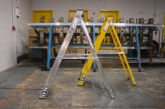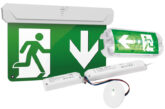
Self-test emergency lighting – it’s the way forward for electrical contractors and their customers. That’s the view of Phil Brown, Director of Product & Marketing at NVC Lighting.
Electrical contractors who work in commercial spaces will know about the need for emergency lighting that automatically illuminates adequately signed exit routes in the event of a dangerous situation.
While the Regulatory Reform (Fire Safety) Order, which makes this requirement law, is unlikely to become a blockbuster mini-series any time soon, it does make it very clear that there are wide reaching requirements for the designated responsible person for commercial buildings and houses in multiple occupation (HMOs).
On top of that, there is also a requirement for regular testing of the system. After all, there’s no point specifying a system that looks great but doesn’t kick in when an emergency actually happens.
Regular testing is essential
BS5266 states that a short functional test is required monthly and a full discharge test (three hours) every year. However, the weakest link in emergency lighting is the human who does the testing. If they skip a test, or fail to spot a malfunctioning fitting, then safety-critical maintenance won’t get done.
Self-test emergency fittings overcome these problems and new technology is making self-test more affordable than ever. It performs all the monthly and annual tests required, but without human involvement. Every month, through holidays and illness, the tests are undertaken automatically, saving costs.
Unlocking the potential of self-test
Longer lasting, more efficient and more environmentally friendly Lithium batteries unlock the potential of self-test emergency lighting. All of NVC’s emergency lighting comes with a seven-year warranty that covers both the light fitting and the batteries. This doesn’t start from the date of manufacture or sale – it starts from the date of installation.
Old battery technology nickel cadmium (NiCd) batteries had no warranty, so nobody could guarantee that the savings from using self-test would ever be realised. Now, with lithium technology, warranted for seven years, the savings keep adding up – year after year.
Addressing addressable
Depending on the building and the budget, addressable self-test emergency lighting is a further option worth considering. Here, a central control system communicates with the individual fittings using DALI. It schedules tests, which are carried out automatically, and collates the test results.
Put in hard cash terms, payback from self-test lighting is often less than two years. Take a recent light industrial unit that we supplied with 54 self-test light fittings, as an example. Previously their sub-contracted testing cost £434 per year. The additional cost of the self-test fittings was £765, resulting in a payback period of 1 year and 9 months! At the same time they’ve also got themselves a more reliable testing regime.
Whether you have your own lighting designers or would like specialist help from our team to design an emergency lighting system with appropriate testing back-up, it’s clear that there are efficiency, cost and environmental benefits that can be gained by installing self-test.
To browse the latest NVC Lighting brochure click here









